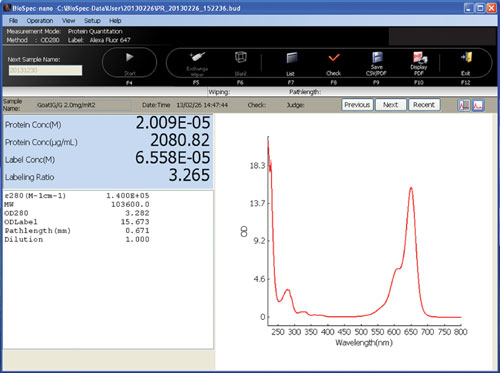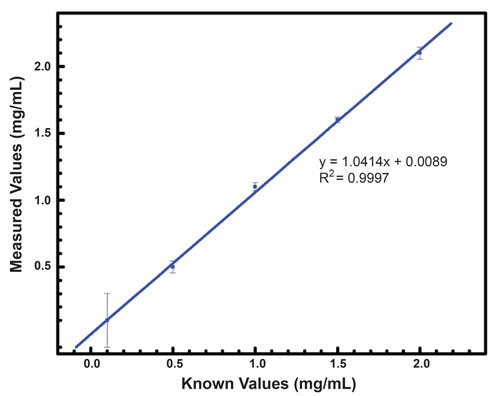January 15, 2015 (Vol. 35, No. 2)
Microvolume Spectrophotometer Designed to Provide Rapid and Simple Analysis
Labeling using a fluorescent dye allows for easy detection of proteins in biological assays. For successful labeling, an optimum amount of the dye has to be used, and excess dye that is not conjugated to the protein or antibody sample has to be removed. Although a high dye concentration provides larger fluorescence peak intensity, a large amount of the dye can lead to fluorescent signal quenching or the deactivation of the protein assays.
It is therefore important to determine the optimum dye-to-protein ratio (alternately referred to as labeling ratio), minimizing signal quenching or deactivation, but providing sufficient fluorescence signal sensitivity to allow accurate concentration measurements.
In this study, the concentration of the protein standards and the dye-to-protein ratio for a labeled protein standard were determined using the Shimadzu BioSpec-nano micro-volume spectrophotometer. These values were automatically calculated based on the measured optical density (OD) and known molecular weights (MW) and molar absorptivities (ε) for both the protein standard and the fluorescent label. The obtained values were then compared to known manufacturer supplied values.
Table 1 provides the formulas integrated into the BioSpec-nano operation software for calculating protein/label concentrations and labeling ratio. A correction factor (CF) is used to adjust the protein signal for any OD offsets due to the presence of the fluorescent label.

Table 1. Concentration and labeling ratio formulas used by the BioSpec-nano.
Experimental Conditions
A prelabeled goat antirabbit immunoglobulin (IgG) fragment protein standard (2 mg/mL) conjugated with the Alexa Fluor® 647 fluorescent label (A-21246, Invitrogen) was used. The molar absorptivity of the IgG fragment, ε, is 140,000 M–1 cm–1 and has a molecular weight of 103,600 g/mol. The Alexa Fluor® 647 fluorescent label has a molar absorptivity, ε, of 239,000 M–1 cm–1 and a molecular weight of 1,200 g/mol.
All dilutions were performed using SAFC Biosciences Dulbecco’s Phosphate Buffered Saline solution (DPBS Modified—pH 7.0-7.4; no calcium or magnesium). The undiluted IgG standard solutions were marked as stock solutions, and serial dilutions using these solutions were carried out to provide calibration standards between 0.1 and 2 mg/mL. All measurements were repeated 10 times. The automatic wiper feature was used to clean the target surface, thus eliminating the need for time-consuming manual cleaning techniques.

Figure 1. Spectrum of Alexa Fluor® 647 dye labeled goat antirabbit IgG fragment protein stock solution (2 mg/mL) with concentration and labeling ratio output.
Results—Agreement between Known and Measured Values
The spectrum for the labeled protein standard is shown in Figure 1. As expected, the excitation band centered at 652 nm related to the Alexa Fluor® 647 dye is clearly visible in the spectrum for the labeled protein standard. In addition, the concentration of the label, the concentration of the protein standard, and the labeling ratio are listed in the BioSpec-nano output window. Table 2 and Figure 2 present the standard calibration measurement results for both the labeled standards.
There is a good agreement between the calculated protein concentration values and the known concentration values. Although concentration can be measured for 0.1 mg/mL, there is poor measurement repeatability for this standard. However, the repeatability improves to below 5% for measured standards above 0.1 mg/mL. The calculated dye-to-protein ratios for these standards are also in good agreement with the manufacturer supplied value of 3.

Figure 2. Linear calibration curve comparing known and measured labeled IgG concentration values.
Summary
The BioSpec-nano demonstrates the ability to quantitatively measure concentrations and labeling ratios for fluorescent dye labeled proteins. In addition, the operation software provides integrated calculators that can be used for the accurate determination of protein and label concentration in addition to the labeling ratio. Besides Alexa Fluor® 647, Cy3, Cy5, and Alexa Fluor® 546 parameters and calculations are also preregistered in the software, with the ability to register up to eight additional labels. The need for a rapid and simple analysis tool for optimizing protein labeling ratios and measuring protein concentration is met with the use of this microvolume spectrophotometer. The included software provides the instrumental capabilities needed for protein analysis in the modern laboratory.

Table 2. Comparison of known values and measured IgG concentration and labeling ratio values.
John Kinyanjui, Ph.D. ([email protected]), is product specialist, molecular spectroscopy, Jeff Head is spectroscopy product specialist, and Mark Talbott, Ph.D., is product manager, molecular spectroscopy at Shimadzu Scientific Instruments.
1 Yoshiyuki Harada, BioSpec-nano Life Science, UV-VIS Spectrophotometer, Shimadzu Talk Letter 7. Document ID #: C101--E120.
2 http://www.lifetechnologies.com/order/catalog/product/A21246. Alexa Fluor® 647 F(ab’)2, Fragment of Goat Anti-Rabbit IgG (H+L). ©2013 Life Technologies Corporation.


